Kickstarter Tabletop Alert: Steal the Spotlight in ‘The Gig’

Tune up your instrument and check your set list—it’s time to play some jazz!
What Is The Gig?
The Gig is a fast-paced roll-and-write game for 1 to 4 players, ages 12 and up, and takes about 20 minutes to play. It’s currently seeking funding on Kickstarter, with a pledge level of £23 (about $29 USD) for a copy of the game. The game is about playing jazz and involves placing dice and forming shapes; though less experienced players may prefer the turn-based variant. It’s generally family-friendly, though I did notice one of the “songs” was titled “B–ches Brew” in case language is a concern for you—the rest of the songs don’t have any profanity in the titles.
The Gig was designed by Jamie Gray, Dann May, Robb Smigielski, and Lewis Shaw. It’s published by Braincrack Games, with illustrations by Dann May, Robb Smigielski, and Lewis Shaw.
New to Kickstarter? Check out our crowdfunding primer.

The Gig Components
Note: My review is based on a prototype copy, so it is subject to change and may not reflect the final component quality.
Here’s what will come in the box:
- 8 Instrument boards
- 16 Song sheets
- 14 Dice (4 each in 4 colors)
- 4 Dice trays
- 15 Set List cards
- 30 Audience cards
- 4 Pens
- 3 Initiative tokens
The prototype had a limited set of components, enough to play the basic game, but didn’t include some of the components, as you can see from my photo. I provided my own dry erase markers and we didn’t have dice trays, but the main gameplay difference from the finished game was the audience cards, which were omitted in the prototype.
The finished dice will be custom dice that have 1 to 6 music notes on the sides rather than regular pips—the notes are arranged roughly in the same configuration as pips on a regular die, but the notes will match the notes on the music sheets, making it easier to place your dice in the right rows.
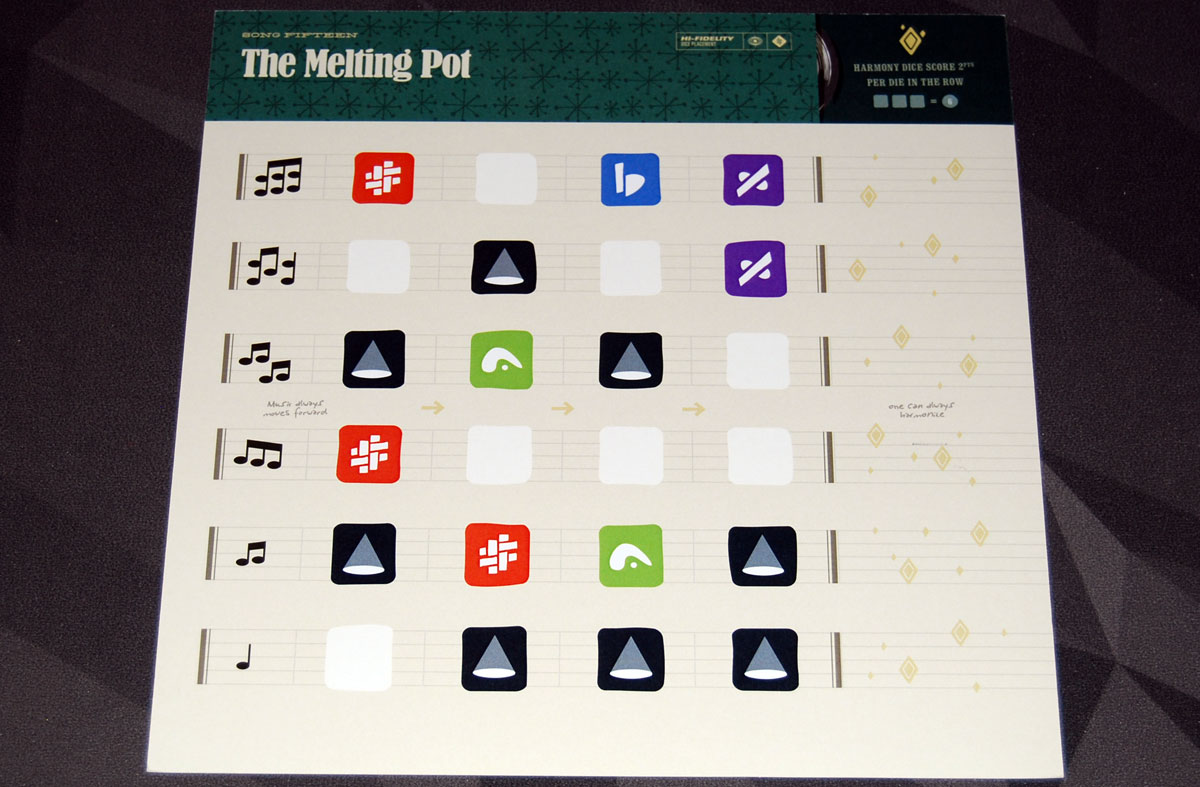
The music sheets will be in a ring-bound book so that you can turn to the right page and lay it flat on the table. (The prototype had separate sheets.) Each page has a song title, and then six rows of music staves with various spaces to place dice. One thing I noticed in a 4-player game was that since we were all reaching over to place dice from different directions, it was easy for the row labels (marked 1 to 6 notes) to get obscured by somebody’s arm—I think it would be nice to have those labels on both the left and right side of each row, just to make it a little more visible.
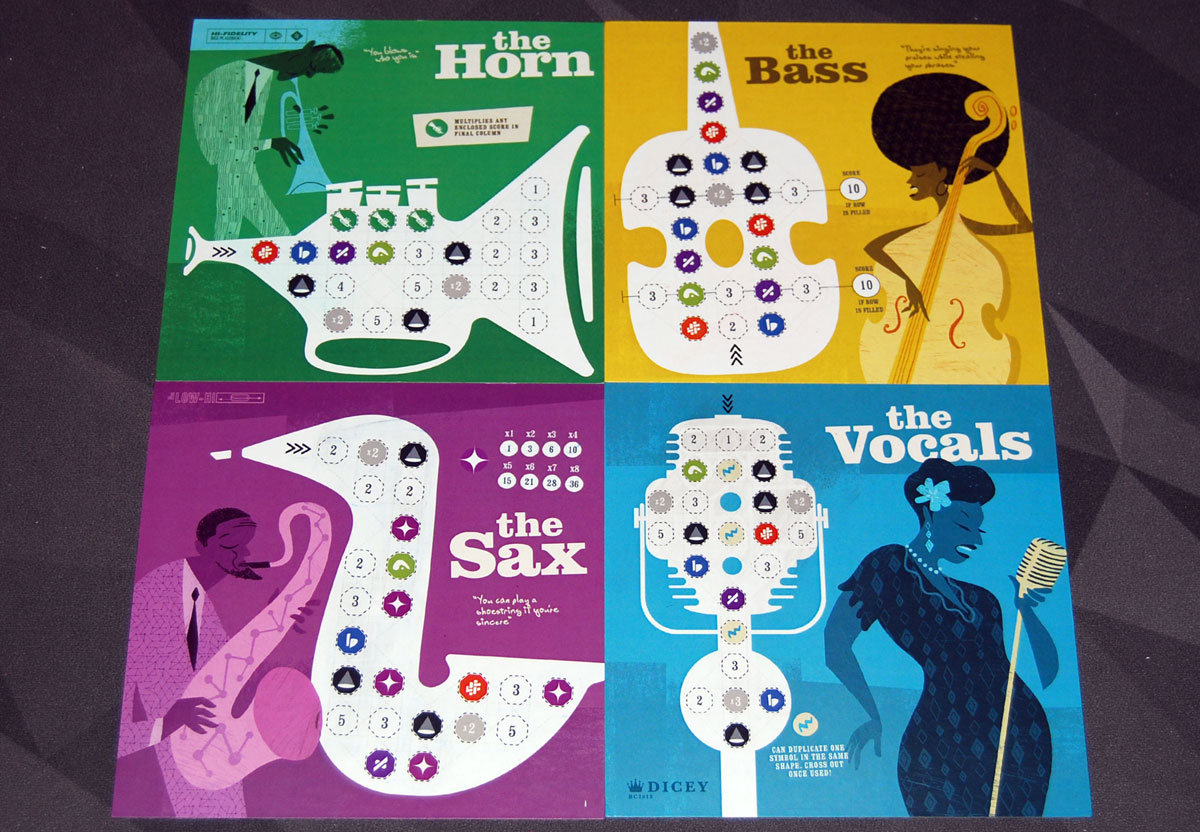
The instrument boards are double-sided: one side has the instrument-specific layout, and the back is a score board with various places to mark spotlights, notations, and scores. Each player will use two boards, one for the instrument and one for the scoreboard. I really love the artwork for the instruments and musicians. The box cover is made to look like a record album, and the musicians are illustrated in a style that looks like something from a music poster, befitting the jazz theme. My only complaint is that the notation called the “rest” looks like a fermata—that’s when you hold a note, but a rest is when you aren’t playing. Most of the instruments also have little quotes about jazz, which is a nice touch. “You can play a shoestring if you’re sincere.” (It would be nice to have the source of those quotes, though—that one is from John Coltrane.)
The finished game will include a dice tray for each player, which may seem like an odd choice, but since the game involves rolling and re-rolling dice in real-time, it’s quite easy for the dice to get away from you, and I think individual dice trays will certainly help with that.
How to Play The Gig
You can download a copy of the rulebook here. It’s also available to try on Tabletop Simulator.
The Goal
The goal of the game is to score the most points through your solo, spotlights, notations, and harmonies.
Setup
Give each player a set of dice, a dice tray, and a pen. Each player takes two instrument boards—one flipped to the instrument side, and one flipped to the scoreboard side.
Choose a set list corresponding to your player count—it will list six songs. Turn the songbook to the first song on the list. Set the three initiative tokens near the song sheet.
If using audience cards (not recommended for your first game), deal out a row equal to the number of players +1.
Gameplay
You will play six songs in a game, and each song has four phases: The Song, The Bridge, The Applause, and The Tune-Up.

The Song
Count in “1, 2, 3, 4” and then everyone can start rolling and placing dice onto the song sheet simultaneously. You may roll your dice as many times as you like until they are placed. Each die must be placed in its matching row, on an empty space. On the right side of the song sheet, there’s a section for harmonies—each row may have any number of dice in harmonies, but only one per player.
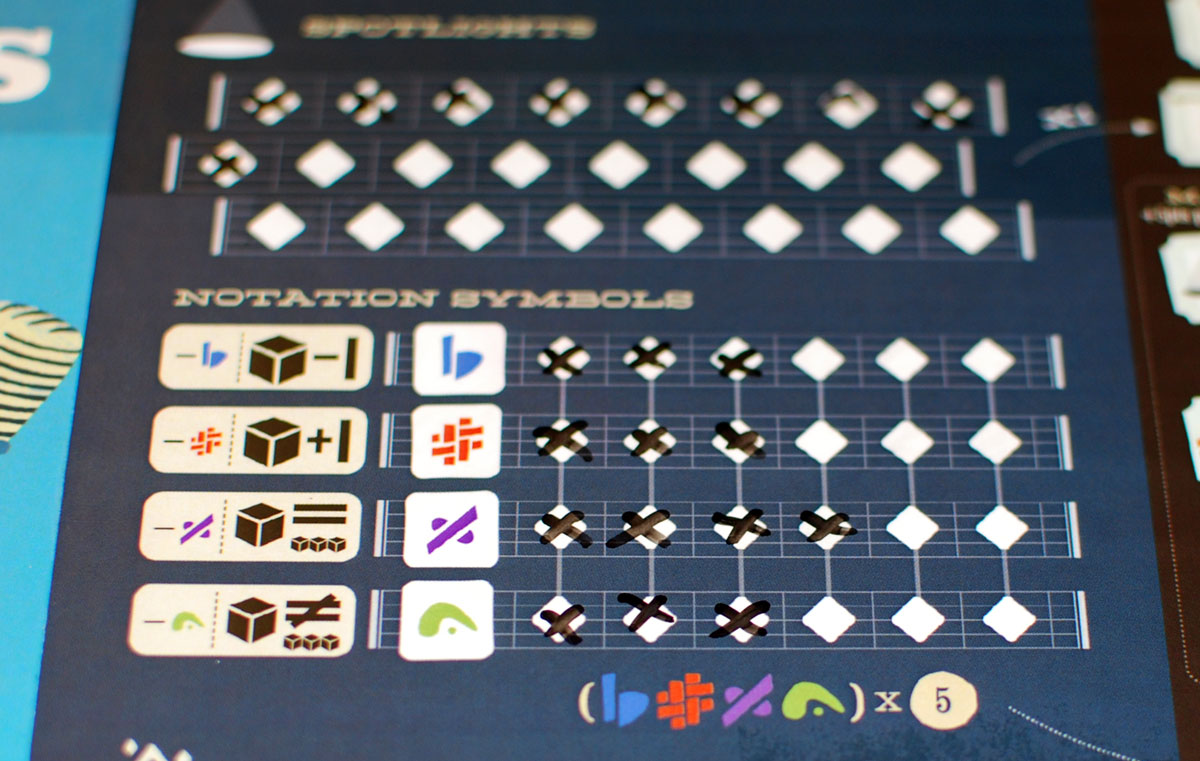
At this point, if you have any notations marked on your scoreboard (you won’t during the first round), you may spend them (erasing the mark) to modify dice before placing them:
- Flat: subtract 1 from your die
- Sharp: add 1 to your die
- Repeat: change 1 die to match any of your other dice
- Rest: change 1 die to a value that is not on any of your other dice.
As soon as one player has placed all four of their dice, they say “Take it to the bridge!” All other players must stop rolling their dice—if you have dice in hand you may roll them one last time—and place them onto the song sheet.
When you finish placing your dice, take the lowest value initiative token available.
The Bridge
Once everyone has finished placing dice, you score for that song. First, check under each of your placed dice—if there are notation symbols or spotlights, check those off on your scoresheet. For each harmony die placed, you score 2 points for each filled space in that row (not counting harmonies), recording it in the space at the bottom of the scoreboard.

Finally, you get to play your solo. You look at your dice in the filled spaces on the song sheet and pick one contiguous group of dice. You then draw that shape (called your “groove”) on your instrument board—you may rotate and flip the shape. Your first groove must start where the arrows point, and then all subsequent grooves must be adjacent (orthogonally or diagonally) to a previous groove. If you enclose any spotlight or notation symbols, you gain those immediately; multiplier spaces will also multiply the number of symbols that are enclosed with them.
The Applause
(If not using audience cards, skip this phase.)
In initiative order, each player may buy or discard one audience card by spending spotlights. The cards have various effects depending on whether they’re bought or discarded.
The Tune-Up
Everyone retrieves their dice, and the songbook is turned to the next song on the set list. If you’re using audience cards, discard the remaining cards and deal out another row.
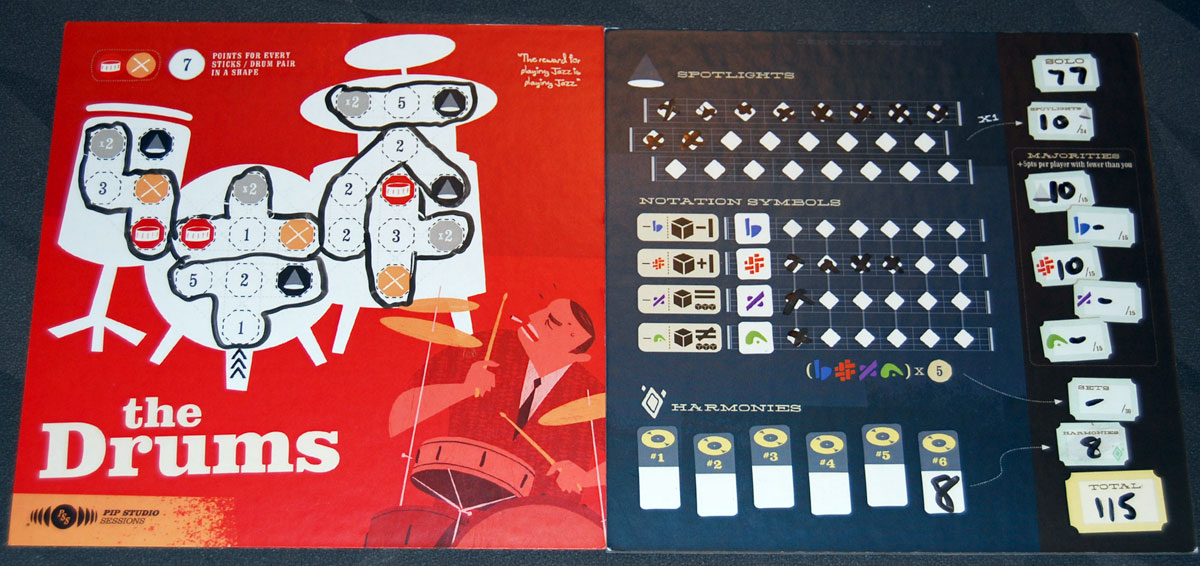
Game End
The game ends after the sixth song.
Players total up their points:
- Solo: add up all the enclosed numbers on your instrument board, taking into account multipliers.
- Spotlights are worth 1 point each.
- Majority bonuses are awarded for spotlights and each notation: 5 points for each player that has fewer than you.
- Set bonuses: 5 points for each full set of flat, sharp, repeat, rest.
- Harmonies: add up your total harmonies scores.
- Audience cards: add up points from any audience cards you have.
The highest score wins! Ties are shared.
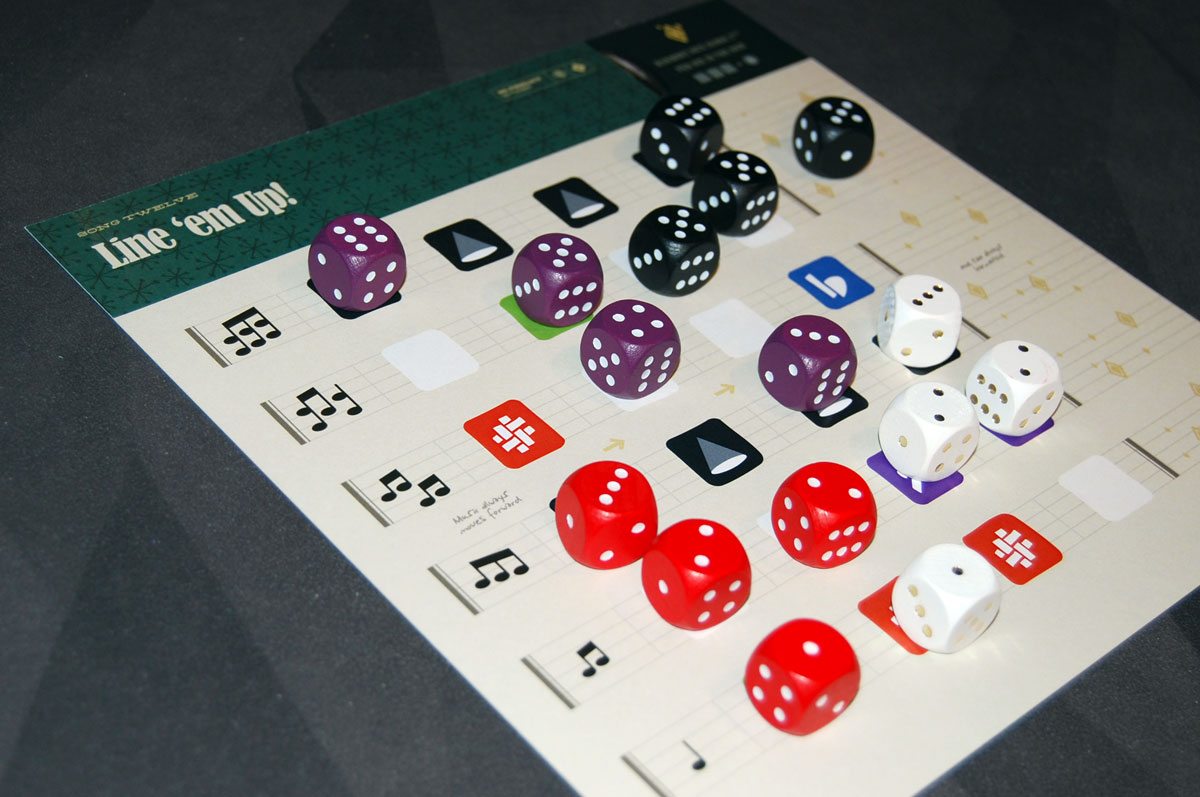
Why You Should Play The Gig
Real-time games can be hit or miss with my gaming group: I’ve always really enjoyed the thrill of time pressure, trying to make decisions on the go, and combining that with dice-rolling is music to my ears. But I get that not everyone likes the frantic pace, and lots of clattering dice, in particular, can be a bit much. In The Gig, there are brief flurries of activity—the Song phases—followed by periods that are a bit more contemplative as everyone decides what groove to pick and how to fit it into their solos. For players who don’t like the real-time scrambling for placing dice, there are optional rules for turn-based play, which still has you rolling dice quickly to determine initiative order, but then lets you place dice in turn order.
The Gig gives you some fun choices to puzzle over. Your solo score is based on the shapes you draw on your instrument board, and each board is unique. They have different layouts, different notations and point values and multipliers, and each one has its own special effect. For instance, the bass has two wider rows of icons—if you enclose every symbol in a row, you’ll score a bonus 10 points. The drums have some drum and stick icons, which award 7 points if you enclose them together… but if you get them together with a multiplier, then that can double those points. The piano has key symbols—when you circle one, you get to pick any notation symbol to earn.
Since the game lasts 6 songs, you’ll get to circle 6 grooves at most (with up to 4 symbols per groove), so you have to think about what symbols you want to group together. That can determine what shape you want your dice to be placed on the song sheet. At the same time, you’re also trying to get notations and spotlight icons on the song sheet, so that may help you decide where on the song sheet to build that shape. Of course, all of that depends on having the right numbers on your dice and getting your dice placed before somebody else takes your spot! It’s a tricky sequence and one wrong note can really throw off your pace.

Grabbing notations has two purposes: first, you can use them to manipulate dice to get those numbers you want. I like the flexibility there, and the way that it (sort of) matches the musical notation: sharps make the numbers go up, flats make the numbers go down, etc. However, notations could also be worth points at the end of the game. Not only do you score points for each complete set, which encourages you to diversify, but you also score points for each symbol if you have more than other players, which encourages you to specialize. And if you spend them to modify your dice, well, you’re spending potential points there! One difficulty in using notations is that it happens during the real-time portion. If you don’t have the right number, do you try to keep rolling, or do you stop, erase a notation, and flip your die to another number? Think fast!
The harmonies are a nice consolation prize for when you’re slower to get your dice placed and all the good slots are taken. Harmony dice won’t help you with your groove, but you score 2 points per filled space in that row. There are 4 spaces per row, so each harmony die you place could get you as many as 8 points. Is circling one more symbol in your groove worth 8 points? If you circle fewer symbols, will you still be able to reach that one bonus spot on your solo? Thematically, I like the idea that harmonies score more points when there are a bunch of people competing for the melody.
I’ve only gotten to play a few times so far, but I love the way each instrument feels different to play. The bass doesn’t have as many points in the solo, but has a lot of notations, which could help for collecting sets or getting majorities. The horn just wants to blast to the end—appropriate. The drums don’t have big multipliers but can provide a steady rhythm. Everyone’s placing dice on the same sheet, but you’re not all trying to build the same shape, so sometimes things clash and sometimes everything works out smoothly. It’s a neat way to represent the musical concept. It’s not just about playing a bunch of random notes but playing a particular sequence or group of notes at the right time. (Of course, a jazz band is typically not a competitive affair, but you can just pretend these are all showy musicians who want to steal the spotlight.)
The one comment one of my players made was that he felt like the game should feel smooth like jazz, but the dice-rolling and placement actually were more chaotic and random. However, it does require you to improvise and think on your feet: if somebody takes a spot you were planning to use, then you need to shift gears and figure out a way to go along with that.

All in all, The Gig does a cool job of representing a jazz band in a game. Its use of dice-placement and shape-drawing is inspired, and I particularly like the way each instrument has its own feel, just as it should. The artwork really helps to sell the story, too—I think this box cover is one that people are going to enjoy having on display.
For more information or to make a pledge, visit The Gig Kickstarter page!
Click here to see all our tabletop game reviews.
![]() To subscribe to GeekDad’s tabletop gaming coverage, please copy this link and add it to your RSS reader.
To subscribe to GeekDad’s tabletop gaming coverage, please copy this link and add it to your RSS reader.
Disclosure: GeekDad received a prototype of this game for review purposes.
Click through to read all of "Kickstarter Tabletop Alert: Steal the Spotlight in ‘The Gig’" at GeekDad.If you value content from GeekDad, please support us via Patreon or use this link to shop at Amazon. Thanks!

